The recently released, science-based Sacramento Valley Salmon Resiliency Strategy is aiming to address the near-and-long-term needs of the Sacramento River’s sea-going fish, primarily the endangered winter-run Chinook salmon, the threatened Central Valley spring-run Chinook salmon and the threatened Central Valley steelhead. The University of California Davis Center for Watershed Sciences and California Trout have recently released statistics that, unless definitive and successful action is taken some 45 percent of California’s 32 species of native salmon and trout could be extinct within the next 50 years.
The state faces considerable economic damage from low harvest rates and the possible closures of commercial and recreational Chinook salmon fisheries throughout the state. As such, on May 24, Gov. Jerry Brown requested the federal government to declare a catastrophic regional fishery disaster and commercial fishery failure in the state. Multiple factors have threatened California’s salmon and steelhead in recent years. Dams, water diversions, warmer temperatures brought on by climate change and habitat loss have been to blame and the state’s recent five-year drought exacerbated the situation.
“In its lifetime, a salmon or steelhead moves from a mountain stream to the high seas, and, as if that’s not enough, then returns to the very stream they were born in to spawn and die,” said California Department of Fish and Wildlife Director Charlton H. Bonham. “Threats face them every mile of the journey. So our efforts to make this migration safer must be strategic and comprehensive. The salmon resiliency strategy released today describes immediate, targeted actions we can take to ensure that more fish survive several critical phases of their remarkable life cycle.”
The resiliency strategy is focused on the freshwater streams where salmon and steelhead eggs hatch, the streams and floodplains where young fish rear and the Delta channels the fish must travel to reach the ocean. Also of importance are the multitude of obstacles that impede adult fish from returning to spawn in their natal streams. Streams fed by snowmelt and springs, which tend to stay cooler for a longer period of time, — such as Mount Lassen, Mount Shasta and other volcanic peaks — have been targeted in the resiliency strategy as previously known refuges for eggs and young fish throughout the summer.
Among other actions within the new strategic plan, California will:
- Improve flows in the relatively pristine Sacramento River tributaries of Mill, Deer, Antelope, and Butte creeks.
- In coordination with the U.S. Bureau of Reclamation, complete the Battle Creek
Restoration Project, which involves, among other measures, removal of a dam on the south fork.
- Reintroduce winter-run Chinook salmon to Battle Creek and McCloud rivers.
- Remove a small rock dam on the Feather River to improve fish passage.
- Restore off-channel rearing habitat in the middle and upper Sacramento River.
- Improve passage of adult salmon through the Sutter and Yolo bypasses, which in some ways mimic natural Sacramento River floodplain.
- Increase the frequency and duration of Yolo Bypass inundation, and
- Restore tidal habitat in the Sacramento-San Joaquin Delta.
Multiple other actions are also being either considered or enacted throughout the state to further aid efforts in improving conditions for the state’s endangered and threatened fish species. More information can be found in the newly released Sacramento Valley Salmon Resiliency Strategy at: www.resources.ca.gov/docs/Salmon-Resiliency-Strategy.pdf.
 California Water News Daily Your Source For Water News in California
California Water News Daily Your Source For Water News in California


